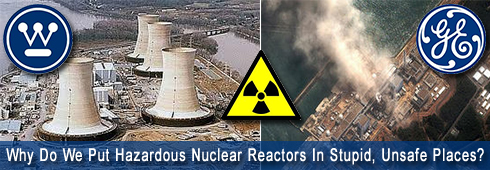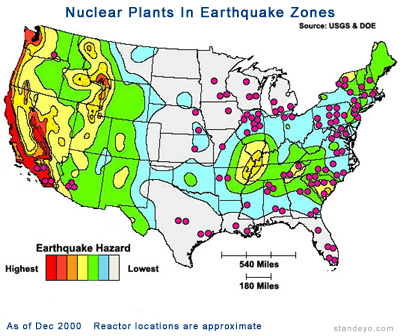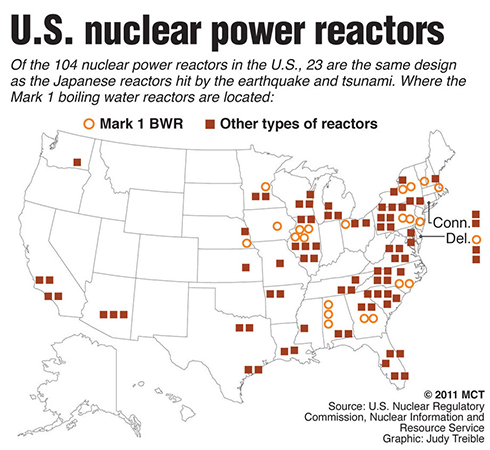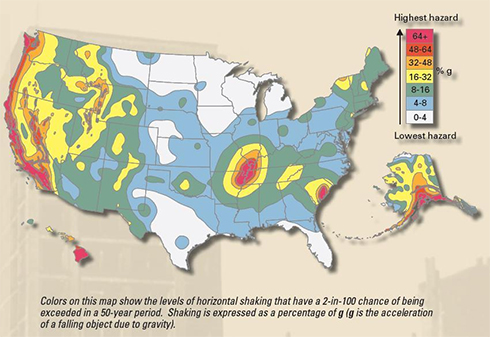 |
|
Nuclear Plant Stupidity |
|
A Commentary On Nuclear Power Safety |
|
For years, activists and anti-nuclear advocates alike have decried the ominous threat that nuclear power plants hold for society. Those groups were labeled as kooks and alarmists by the big money powers that personally benefit from the proliferation of nuclear energy. If you didn't get the message before from Three-Mile Island, or the Chernobyl disaster, it would seem that now after the Japanese disaster the truth is undeniably in front of us; nuclear power is a serious threat to life as we know it on planet earth. This is news only for those that never bothered to listen to the so-called kooks and alarmists. Only now do those who have had their heads in the sand for so long finally see the light, but it could be too late. With six reactors failed and in the process of meltdown, the Honshu earthquakes now stand as the worst disaster to threaten the earth. This isn't just a disaster for the island nation of Japan, but for the entire world. Not only is the risk of radiation contamination a dangerous reality from blowing winds, but also from the high altitude jet-stream which can carry radioactive dust across whole continents, threatening vast populations with deadly airborne particulate and toxic nuclear rain. The biggest threat being missed by the media to date is the poisoning of the entire Pacific Ocean, and all life within it. This affects the food source for many, and seriously jeopardizes the fishing industry. How can anyone possibly eat fish anymore in good confidence? All around the Pacific rim, those countries that rely on fishing as an industry and food source are now in deep trouble. It isn't just the Pacific, as eventually the radioactive contamination will makes its way around the world. This is a disaster of epic proportions. Many have not yet realized the totality of this awful event, but they soon will. And when they do realize what they've lost, they are are going to demand answers. The one answer that many will seek, how could we have been so stupid to place such dangerous reactors in such critical locations that endanger all those around them? Sadly there will be some who defend nuclear power, claiming that the reactors would have been safe had it not been for the tsunami, but they would be remiss in failing to recognize that there is no safe place on the earth when it comes to mother nature. Whether it be a category five tornado, hurricane, or earthquake, there is always the possibility for disaster. So why then did man tempt his own fate by building these nuclear threats in such precarious locations, earthquake fault lines and waterways? For anyone to think that a tsunami is a big surprise for an earthquake prone island surrounded by an ocean is absolute ignorance at its highest. Are we that stupid? Japan is certainly not the only bad idea for nuclear power. One only has to look as far as the U.S. to find many reactors built on top of dangerous tectonic fault lines. When you know full well the repercussions of a nuclear meltdown, why in the world would anyone build a reactor on top of a fault line, let alone a major waterway that has the potential to affect so many? It is absolute madness, but hey, I guess for some hindsight is always 20-20. Intuitive foresight is lost reason for them. California, the land of earthquakes, has two nuclear reactors built near fault lines, Diablo Canyon and San Onofre. The alarming prospect is that the Diablo Canyon plant was only designed with a maximum stress level of 7.5. The San Onofre plant, built between the major metropolitan areas of San Diego and Los Angeles, has a maximum stress level of only 7.0. Again, all of this in prime earthquake country. To top it all off, the San Onofre facility is very near the ocean, but plant operators like to boast of its 25 foot tall concrete tsunami wall. Someone needs to remind them that the Japan tsunami was 33 feet tall. It's bad enough that the Fukushima reactors were only built to withstand a 7.9 quake, but the California situation borders on pure insanity, if not criminal negligence. And then you have arguably the most dangerous reactor in America, the Hanford reactor, originally built during WWII, it has had numerous issues over the years, one of which is contaminating the ground water and the Columbia River with radioactive coolant discharge. This facility has eight reactors and is a serious threat to the U.S., should the Pacific Northwest ever have a devastating earthquake. The jet-stream there would take radioactive particulate across the U.S. and southern Canada very quickly. And then we have potentially the most dangerous earthquake fault in America, the New Madrid fault in southern Missouri and southeast U.S. There are no less than 15 nuclear reactors built within this dangerous quake zone. These are not the only reactors at risk for earthquakes in the U.S. (see map)
Are you starting to see the error in foresight here? Not only are they dealing with dangerous, threatening technology to begin with, they have then placed these reactors in some of the most precarious and dangerous spots that anyone in their right mind could ever possibly think of. This is only the beginning of the myopia in nuclear design. Most nuclear reactors are built near large rivers or public waterways, where the threat of contamination can spread easily to areas outside the reactor zone. Three mile Island is just one of many. In Iowa, they only have one nuclear reactor, the Duane Arnold Energy Center, but it is built upstream on the Cedar River, just a few miles north of Cedar Rapids, one of Iowa's largest cities. That same river also runs through a major college town just scant miles south in Iowa City. This plant also just so happens to dump its cooling water just hundreds of yards upstream from the public boat launch at the local park there. Where was the foresight in that reactor location? And speaking of the Duane Arnold reactor, this reporter used to be a broadcaster in Cedar Rapids in the early 80s. I had a good friend who was a welder there. He told me that he had worked on the Duane Arnold plant and that it was not a safe facility. When asked why, he told me matter of factly that they had run out of the proper brazing rods during construction, and were told to use an improper substitute in order to keep the construction on schedule. With that in mind, Iowa is not historically quake territory, however, it is big tornado country. An ominous threat if ever there was one. So who is responsible for such lapses in common sense and foresight with our nuclear plant construction? Well, you have to look at the facility owners, plus the Atomic Regulatory Agency (AEC), but some culpability also has to go to the manufacture of these facilities who profit tremendously. Many of the reactors around the world are built by General Electric (GE) and Westinghouse. The Japan Honshu Fukushima reactors were designed and built by GE. Will anyone hold them accountable for their role in the minimal design and questionable placement of these ticking time bombs? After reading this, you might ask why these facilities aren't built to a higher stress level? One answer... money, good ol' cost and profit. It's that simple. One of the most dangerous technologies known to man, with far reaching ramifications for public safety, and it all comes down to scrimping for a buck. And if their defense is that you can't spend enough to possibly make these reactors safe from all natural disasters, wouldn't you think that would be a solid qualifier for not investing in such dangerous technology? We have gun manufactures and car companies sued as contributing parties in many wrongful death suits, so when are we going to hold the big corporations such as GE and Westinghouse rightfully responsible for their roles in unsafe reactor designs? I suppose the Gulf disaster and the fact that BP got off scot-free is a bad omen here. Lastly, one can only hope that after the Japan disaster, people of the world might re-think their position on the use of nuclear power, especially when we already have other power sources which could easily take the place of this antiquated and dangerous technology. Hats off to German Chancellor Andrea Merkel for immediately shutting down seven of Germany's reactors that were built before 1980. Let's hope the rest of the world can stand up to the big money interests, such as GE and Westinghouse, and say no more to nuclear power. The planet will be a much better place for it, but will always carry the scar of Honshu for thousands of years to come. NewsFocus thinks it would be a good precautionary move for the U.S. to take steps now to prepare its nuclear facilities. Perhaps shutting them down temporarily before the peak period would be a prudent move. Just sayin'... Update: Potassium Iodide Recalled By Government There have been media reports that the main reason U.S. residents cannot find the much sought after potassium iodide is because the government has recalled it. The reason why is pure speculation at this point. Until a spokesman from the Obama administration comes forward, we have only two things that could be reasonably assumed, either they're sending it to Japan, or else they're saving it in the event of a reactor breach here in the U.S. If indeed the latter is true, that is cause for alarm, as it would be an admission that up to this point, state and federal emergency preparedness around US reactors is lacking, if not inadequate, or worse, we have had nothing in place to begin with. And if they're sending it all to Japan, what then if we have major quakes here, and the Diablo, San Onofre or Indian Point reactors should become breached? What about those 15 reactors in the New Madrid zone? Arguably, the best practice in life is to always err on the side of caution, however, the recall of KI (potassium iodide) at this time, under these conditions, is understandably bringing more questions for the public than it has ease and comfort. The 10 Highest Risk Nuclear Power Plants In The US Half of U.S. nuclear reactors over 30 years old Database of active nuclear reactors US Support For Nuclear Power Drops And Finally, A Word of Warning: I truly hate to say this, but the reason to do so has valid precedent...think long and hard about what you hear from the government on radiation warnings. Please remember... they lied to us about the toxic air quality at ground zero after 9/11. As bad as this is to say, if the situation is out of their control, they would rather not admit a powerless situation and would more than likely defer towards keeping the story under wraps in an effort to maintain an image of control. They would likely opt for civil order, preferring instead to deal with the case-by-case ramifications as they arose. That is, for all intents and purposes, easier for them to deal with than mass panic. Again, it's happened before. After 9/11, many have died, and will continue to die, all because we were lied to us about the air quality. They willing did so simply because they wanted to get Wall Street up and running again. They made a trade off. Lives for money. And in the end we all know how Wall Street paid us back for that high priced favor, they tanked our economy. Thanks for reading. Graphic: World Nuclear Reactors Graphic: US Nuclear Map Graphic: Current quakes and US nuclear facilities Graphic: US quake activity and nuclear plants
|



